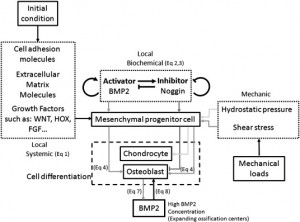If we understand how biomechanical bone formation is induced from mesenchymal stem cells we can induce new bone growth to reinvigorate longitudinal growth.
A computational model of clavicle bone formation: A mechano-biochemical hypothesis.
“Clavicle development arises from mesenchymal cells condensed as a cord extending from the acromion towards the sternal primordium. First two primary ossification centers form, extending to develop the body of the clavicle through intramembranous ossification. However, at its ends this same bone also displays endochondral ossification. [These] embryological events [occur in] two serial phases: first formation of an ossified matrix by intramembranous ossification based on three factors: systemic, local biochemical, and mechanical factors. After this initial phase expansion of the ossified matrix follows with mesenchymal cell differentiation into chondrocytes for posterior endochondral ossification. Our model provides strong evidence for clavicle formation integrating molecules and mechanical stimuli through partial differentiation equations using finite element analysis.”
“areas of low octahedral shear stress and high hydrostatic stress promote bone formation by endochondral ossification. On the contrary, areas of octahedral shear stress result directly in osteogenic induction.”
“hydrostatic stress promotes mesenchymal cell into a cartilaginous differentiation pathway, whereas octahedral shear stress stimulates mesenchymal cells to differentiate into bone.”

